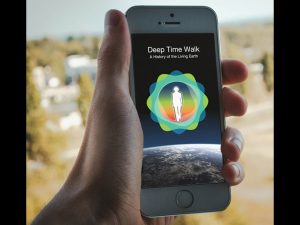Links
Gaia Theory Wikipedia Page | The Guardian: Article on Gaia Theory
Gaia Hypothesis – article on the website “Environment and Ecology”
Deep Time Walk – “this is a 4.6 km walking audio book for smartphones telling a history of the living Earth. This unfolding takes you from [4.6 Billion Years Ago] to the present day, with each metre walked representing 1 million years. During the dramatised walk between a fool and a scientist you learn from the latest scientific evidence about how our planet evolved over this vast stretch of geological time, including the accretion of the Earth from a disc of rocky debris, the formation of the oceans and atmosphere, the appearance of first life – bacteria, then the first nucleated cells and multicellular organisms.”
NOVA: Goddess of the Earth – 1987 film on Gaia Hypothesis – This film is, unfortunately, still the best video (that I know of) about Gaian science (and some other aspects of the Gaia idea). There is much, much more known, now, about the overall view of Earth as a single living system and most of this information has been incorporated into “Earth System Science” (as it evolved from “Earth Science” during the 1990s and 2000s). However, this 1987 film convincingly supports the scientific validity of the Gaian idea while also effectively connecting the idea to our humanity, our humanities, our emotional connections to Earth. Watch this film and then advocate for a new and updated version!
Why Most Planets Will Either Be Lush or Dead; The Gaia hypothesis implies that once alien life takes hold, it will flourish. – 2016 Article in “Nautilus” by astrobiologist, David Grinspoon.
When Life Went Global – a 2014 interview with astrobiologist, David Grinspoon, in Astrbiology Magazine
The Cosmic Gaia Hypothesis and the Copernican Principle – a 2017 review of Grinspoon’s ideas on Gaia Theory that ends with the following sentiment: “Surely it would be irony should a species evolve intelligence enough to come to know of Gaia, come to know that it is killing Gaia, yet do little or nothing to arrest the atrocity as atrocity it is.”
Terra Sapiens — planetary changes of the fourth kind – a 2014 video of a Ted Talk by David Grinspoon
Images
The classic “Earthrise” (Apollo 8, December 1968), first time humans saw Earth against the void context of space: View Here
“Black Marble” Earth at night, good for quickly discerning how urban parts of the world are: View Here
Original “Blue Marble” (Apollo 17, 1972): View Here
“Pale Blue Dot” (Voyager 1, 1990). Carl Sagan wanted a picture of a tiny Earth awash in a sea of stars. This image is subtle in its beauty, but Sagan’s romantic musings it inspired make it great: View Here
A series of beautiful NASA shots of Earth: View Here
Sunset over the Pacific Ocean south of Japan as seen from the ISS: View Here
40 pages of NASA Earth photos: View Here
NOAA Data Sets – imagery and videos of a wide variety of Earth systems: View Here


